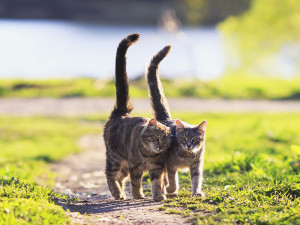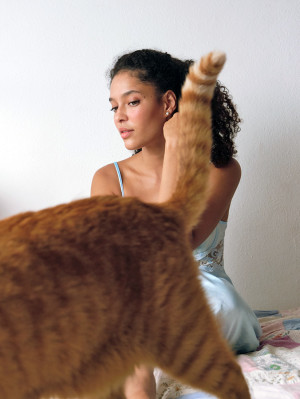Why Does My Cat’s Tail Vibrate?
They’re trying to tell you something... but what?

Share Article
In This Article:
Cat Tails and Body Language Reasons Why Cats Vibrate Their Tails Frequently Asked Questions
If you are a cat parent, you’ve probably seen it before: Your cat’s tail is vertically positioned and vibrates as it sticks straight up in the air. But what does this strange behavior mean? Cats’ tails may vibrate as a sign of excitement, anticipation, or arousal, often seen during greetings or when using urine to mark their territories.
This behavior is a natural reflex controlled by the nervous system and typically indicates heightened interest or readiness to engage in activity. It’s a common feline communication method used to express various emotions or intentions. But a cat’s tail has a lot to say, so let’s take a closer look at what those vibrations actually mean.
Cat tails and body language
Feline body language is conveyed through the ears, eyes, whiskers, body position, fur, and yes, the tail. A cat’s tail position plays a key part in feline body language and is often one of the most obvious signals cats use to communicate emotion. This is because the cat’s tail position can be seen from a distance, which can be useful when it comes to greeting an unfamiliar cat…how is that cat feeling, and are they up for a social interaction, or should we stay away and come back another time?

Communication using “tail-speak” is helpful not only between humans and cats, but also between cats themselvesopens in new tab, and can help cats avoid conflict, fights, and other unpleasant circumstances.
Context of situation
When interpreting your cat’s body language, it’s important to take into account the context of the situation: Is your cat with friendly familiar cats, or is there stranger-danger with an unfamiliar cat who is approaching? Is your cat just waking up from a nap, hungry, or in a playful mood? Is your cat comfortable in their home territory, or are they in an unfamiliar setting that may be causing some anxiety? Some body language features can have multiple meanings, so context is very important to correctly interpret the signs your cat is conveying.
Tail position and movements
There are several tail positions and movements that indicate how a cat feels at any given time. Generally, the higher up a cat’s tail is, the more confident and friendly they are (although there are exceptions!). A cat whose tail is straight up or up and curved at the tip is feeling social and happy to see you.
A cat whose tail is wrapped around them or low to the ground might be feeling insecure or anxious. A cat whose tail is thumping or twitching back and forth is probably feeling irritated, so proceed with caution! And a cat whose fur is all puffed up on the tail and/or back (i.e., piloerect) is angry or afraid, so limit your interactions with them.
Reasons why cats vibrate their tails
The vibrating cat tail appears under certain circumstances: when you pet your cat, or when your cat sees you, or even other situations. There are a few reasons why you may see your cat’s tail vibrate or shake, but it’s generally thought that shaky-tail is the result of excitement or anticipation. Here are some specific reasons why your cat’s tail might be vibrating:
Happiness
If you’re fortunate to have good relationships with your kitties, you probably see tail vibrations regularly when your cat approaches you, or other cats they are friendly with. Congratulations! Tail vibrations are high praise and say many positive things about how your cat feels about you, so take that shaky tail as a huge compliment.
Urine-spraying behavior
When a cat sprays urine, they’ll typically back up against an object with their tail raised vertically and spray a stream of urine directly behind them, as their tail quivers and vibrates. However, they can also do the exact same thing but without any release of urine; this is known as “phantom spraying” (in my family we lovingly refer to it as “tinkle tail”), and the triggers and reasons for the behavior are the same as for regular spraying.
There’s nothing to be concerned about with this behavior, but if your cat is doing this because they are anxious or feeling territorially insecure, it’s best to address those issues for the comfort and well-being of your cat.
Anxiety
As mentioned above, phantom spraying can be the result of anxiety or insecurity; this is accompanied by a vibrating tail, as described. Anxiety can also result in the cat’s tail being in motion more than usual, for example, moving back and forth when there’s nothing particularly stimulating happening for the cat. If you suspect your cat is anxious about something, try initiating a play session with an interactive wand toy to see if you can help your cat release some of that nervous energy in a productive way.
Impatience
You know how some people tap their feet when they’re waiting on someone? A cat can tap or shake their tail under the same circumstances, so hurry up with that food or toy. It’s not necessarily the same “vibration” as described above, but if you see a cat whose tail is partially moving or swishing, they could be waiting (not so patiently) for you to do something for them.
Anger
An angry cat will have less of a vibrating tail and more of a tail that swishes back and forth rapidly, or thumps vertically on the ground. The more that tail is moving, the more you’d better take care to stay out of that cat’s way! Or, if you know what’s bothering that cat, do your best to rectify the situation. Then, perhaps the next time the cat sees you, you’ll get a vibrating tail for a much better reason!
In my experience, the most common reasons why cats have vibrating tails are 1) excitement to see human companions, and 2) urine-spraying behaviors (including phantom spraying). Even our old lady cat, Samantha, vibrates her tail on a daily basis, usually when we’re preparing her evening dinner and she comes in to tell us how hungry she is! We know she’s excited about us preparing her meal, and her vibrating tail is a dead giveaway for her emotions.
I see anxiety, impatience, and anger as less common reasons why a cat’s tail might vibrate, but those are certainly emotions that evoke cat tail movements including swishing, twitching, and thumping. A cat’s tell-tale tail seems to always have something to say depending on how kitty feels, and it’s a great barometer for human guardians to use while gauging our cats’ emotions.
FAQs (People also ask):
Is it normal for a cat’s tail to vibrate?
It is normal for a cat’s tail to vibrate; this is part of the regular cat body language repertoire and aids in communication between other cats and humans. Cats have a wide range of tail movements, including vibrating or “shaky-tail”, and many cats use a vibrating tail regularly to express happiness and excitement, or while they are spraying (or phantom spraying).
What does a vibrating cat tail mean?
A vibrating cat tail can mean several things, including happiness to see you (or another friendly cat), anxiety, impatience, or even anger. Additionally, a cat’s tail will vibrate when they are going to spray urine, or sometimes even without urine (known as phantom spraying). When you see a cat tail vibrating it’s generally an indicator of excitement, anticipation, or arousal of some kind.
Why is my cat twitching?
Cats can move a lot in their sleep, including making twitching movements while dreaming, experiencing muscle spasms with deep relaxation, and with some medical conditions like allergies or seizures. And watch out for that twitching tail; sometimes cats who are on the verge of sleep twitch or swish their tail to keep others from bothering them.
References:

Marci Koski
Marci Koski fell in love with cats as a toddler and never looked back, even leaving a career as an endangered species biologist for the U.S. Fish and Wildlife Service to start her own cat behavior consulting service, Feline Behavior Solutions in 2014. Since then, Marci has been helping people resolve their cat behavior issues by teaching people “how to cat” — namely, how to give their cat the resources and environments they need to thrive with their human companions.
Marci has a PhD in Fishery and Wildlife Biology, and earned her specialized and advanced Feline Training and Behavior certifications through the Animal Behavior Institute.
Related articles
![Cat kneading pet parent]()
Why Does My Cat Knead Me?
Among other things, “making biscuits” is a sign of affection. We’re not crying…
![cat staring at person on table]()
Why Does My Cat Stare at Me?
...Is it something you said?
Why Does Your Cat Pee on Your Bed?
It’s a clear sign something isn’t right.
Why Does My Cat Poop Outside of the Litter Box?
The worst kind of surprise.
Why Does My Cat Meow at Night? (And How to Prevent It)
Just a small request to lower the volume, please.








